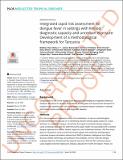| dc.contributor.author | Belau, Matthias | |
| dc.contributor.author | Boenecke, Juliane | |
| dc.contributor.author | Ströbele, Jonathan | |
| dc.contributor.author | Himmel, Mirko | |
| dc.contributor.author | Dretvić, Daria | |
| dc.contributor.author | Mustafa, Ummul-Khair | |
| dc.contributor.author | Kreppel, Katharina | |
| dc.contributor.author | Sauli, Elingarami | |
| dc.contributor.author | Brinkel, Johanna | |
| dc.contributor.author | Clemen, Ulfia | |
| dc.contributor.author | Clemen, Thomas | |
| dc.contributor.author | Streit, Wolfgang | |
| dc.contributor.author | May, Jürgen | |
| dc.contributor.author | Ahmad, Amena | |
| dc.contributor.author | Reintjes, Ralf | |
| dc.contributor.author | Becher, Heiko | |
| dc.date.accessioned | 2025-04-04T10:58:37Z | |
| dc.date.available | 2025-04-04T10:58:37Z | |
| dc.date.issued | 2025-03-28 | |
| dc.identifier.uri | https://doi.org/10.1371/journal.pntd.0012946 | |
| dc.identifier.uri | https://dspace.nm-aist.ac.tz/handle/20.500.12479/2997 | |
| dc.description | This research article was published by PLOS Negleted Tropical Diseases Volume 19,2025 | en_US |
| dc.description.abstract | Background
Dengue fever is one of the world’s most important re-emerging but neglected infectious diseases. We aimed to develop and evaluate an integrated risk assessment framework to enhance early detection and risk assessment of potential dengue outbreaks in settings with limited routine surveillance and diagnostic capacity.
Methods
Our risk assessment framework utilizes the combination of various methodological components: We first focused on (I) identifying relevant clinical signals based on a case definition for suspected dengue, (II) refining the signal for potential dengue diagnosis using contextual data, and (III) determining the public health risk associated with a verified dengue signal across various hazard, exposure, and contextual indicators. We then evaluated our framework using (i) historical clinical signals with syndromic and laboratory-confirmed disease information derived from WHO’s Epidemic Intelligence from Open Sources (EIOS) technology using decision tree analyses, and (ii) historical dengue outbreak data from Tanzania at the regional level from 2019 (6,795 confirmed cases) using negative binomial regression analyses adjusted for month and region. Finally, we evaluated a test signal across all steps of our integrated framework to demonstrate the implementation of our multi-method approach.
Results
The result of the suspected case refinement algorithm for clinically defined syndromic cases was consistent with the laboratory-confirmed diagnosis (dengue yes or no). Regression between confirmed dengue fever cases in 2019 as the dependent variable and a site-specific public health risk score as the independent variable showed strong evidence of an increase in dengue fever cases with higher site-specific risk (rate ratio = 2.51 (95% CI = [1.76, 3.58])).
Conclusions
The framework can be used to rapidly determine the public health risk of dengue outbreaks, which is useful for planning and prioritizing interventions or for epidemic preparedness. It further allows for flexibility in its adaptation to target diseases and geographical contexts. | en_US |
| dc.language.iso | en | en_US |
| dc.publisher | Public Library of Science | en_US |
| dc.subject | Research Subject Categories::NATURAL SCIENCES | en_US |
| dc.title | Integrated rapid risk assessment for dengue fever in settings with limited diagnostic capacity and uncertain exposure: Development of a methodological framework for Tanzania | en_US |
| dc.type | Article | en_US |

